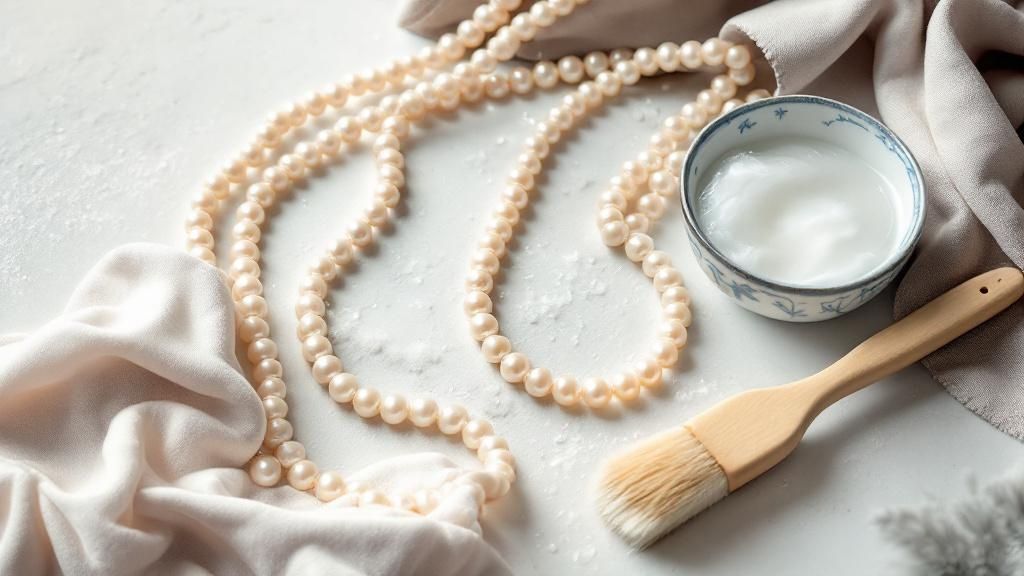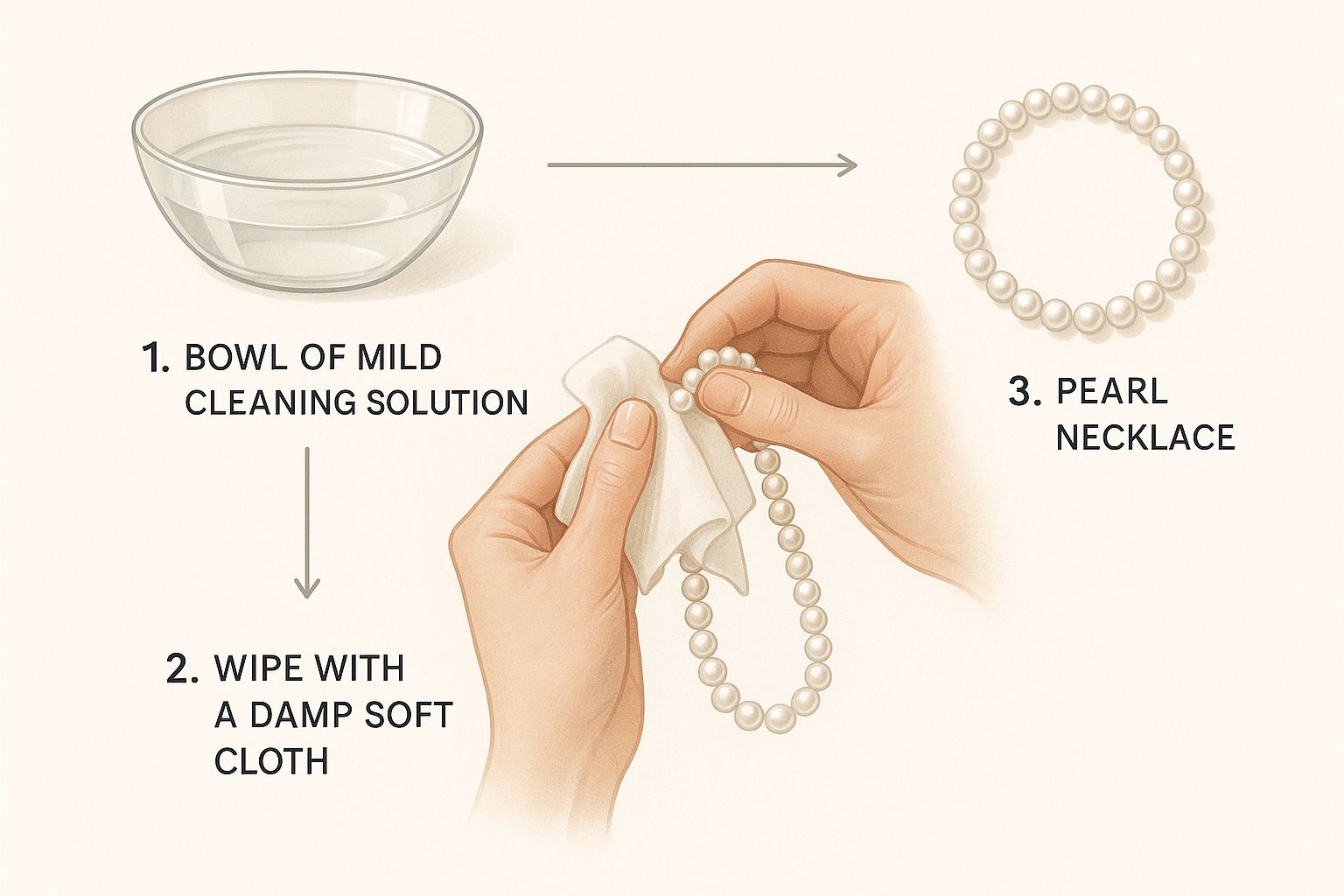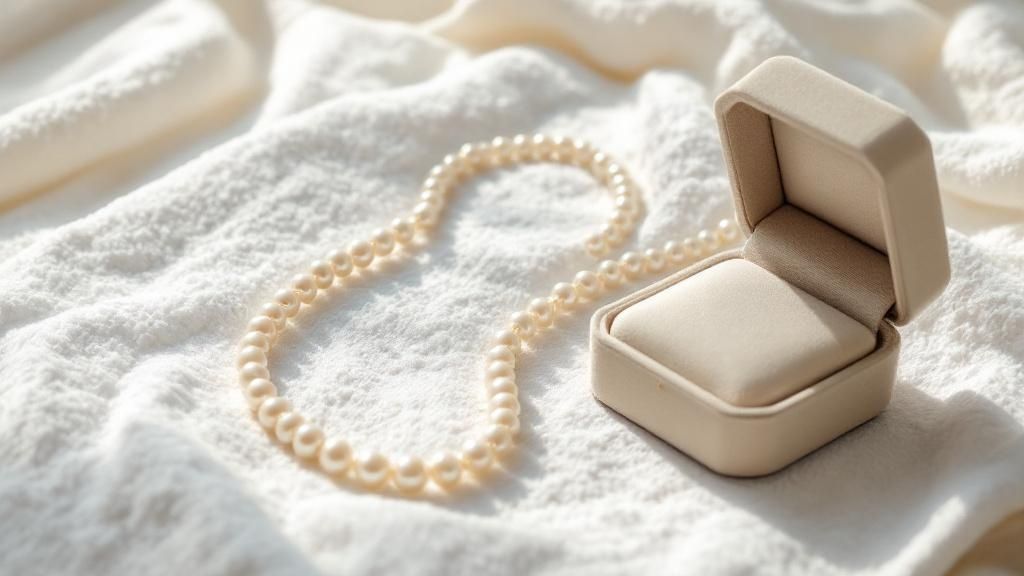How to Clean a Pearl Necklace: Easy Cleaning Tips
- Luke Zucco
- Jul 21
- 10 min read
The secret to cleaning a pearl necklace is a gentle touch. All you need is a soft, damp cloth and a simple mix of lukewarm water with a single drop of pH-neutral soap. Gently wipe each pearl, one by one. The most important thing to remember is never to soak the strand—this can damage the nacre and, worse, weaken the silk thread holding everything together.
Once you’re done, lay the necklace flat on a towel and let it dry completely before wearing or storing it.
Why Your Pearls Demand Special Care
Before you even get a cloth wet, it's crucial to understand why pearls need such specific care. It’s the key to keeping them beautiful for years. Unlike diamonds or sapphires, which are hard minerals mined from the earth, pearls are organic gems. They are built from delicate layers of calcium carbonate, making them incredibly soft and prone to damage.
I always tell my clients to think of a pearl's surface—its nacre—like sensitive skin. It scratches easily, so rough cloths are out. It also reacts badly to acids and chemicals, which can eat away at its luster. That’s why properly cleaning a pearl necklace is less about scrubbing and more about mindful, gentle maintenance.
The Science of Pearl Delicacy
The very thing that makes a pearl beautiful is also what makes it so fragile. Everyday chemicals in things like perfume, hairspray, and even highly chlorinated tap water can cause real, irreversible harm. You might see this as a dulling of the shine, a chalky film, or even tiny pits on the surface.
The biggest mistake I see people make is treating their pearls like any other gemstone. Their organic nature means they can't handle acids, harsh cleaners, or big temperature swings, which can literally break down their structure.
Improper care is the fastest way to ruin a beautiful necklace. As a jeweler, I can tell you that a staggering amount of the damage we see comes from well-intentioned but incorrect cleaning and storage. Industry-wide, it's estimated that 70% of pearl damage is due to owner habits, like using the wrong cleaners or soaking the jewelry. You can dive deeper into these common pitfalls with insights from professionals in the fine jewelry care industry.
To make it simple, I've put together a quick guide to what you should and shouldn't let near your pearls.
Safe vs. Unsafe Cleaning Agents for Pearls
Knowing what to grab—and what to avoid—can make all the difference. This table is your go-to cheat sheet for protecting your pearls.
Safe for Pearls ✅ | Unsafe for Pearls ❌ |
|---|---|
Ultra-soft, lint-free microfiber or cotton cloths | Abrasive materials like toothbrushes or terrycloth towels |
Lukewarm distilled or purified water | Hot or cold tap water (which can contain harsh minerals) |
A tiny drop of pH-neutral, mild soap (like baby soap) | Vinegar, lemon juice, or any acidic cleaners |
Professional pearl cleaning solutions | Baking soda, ammonia, or chlorine bleach |
Ultimately, sticking to the "safe" column ensures your pearls remain luminous. When in doubt, simpler is always better.
Gathering Your Gentle Cleaning Toolkit

Before you even think about touching your pearls, let’s get your supplies in order. Having the right tools ready makes all the difference between a safe cleaning and a potential disaster. This isn't about just grabbing any old rag; it’s about setting up a proper, professional-style station to protect your investment.
Your most crucial tool is the cloth. It needs to be ultra-soft and completely lint-free. Think along the lines of a high-quality microfiber cloth designed for camera lenses or even a fresh piece of 100% cotton. Stay away from standard terrycloth towels. Even the softest ones have tiny, abrasive loops that can inflict micro-scratches on a pearl's delicate surface, known as the nacre.
You’ll also need two small bowls. Dedicate one for your mild cleaning solution and the other for plain rinse water. This simple separation is key—it stops you from accidentally redepositing the dirt and oils you just carefully wiped away.
Choosing the Right Water and Soap
The liquids you use are just as important as the cloth. Regular tap water is a no-go. It often contains chlorine and minerals that can be surprisingly harsh on a pearl’s luster over time.
Distilled or Purified Water: I always recommend using lukewarm distilled water. It's pure, meaning it won’t leave behind any dulling mineral deposits that can build up on your pearls.
A Truly pH-Neutral Soap: You’ll need a very mild, pH-neutral soap. And when I say a little, I mean it—a single, tiny drop is more than enough. Harsh detergents or soaps containing acidic elements (like citrus) can literally eat away at the nacre.
The whole point here is to gently lift away body oils and everyday grime, not to scrub or disinfect. Think of this as a protective spa treatment for your pearls, not an aggressive deep clean.
With these simple items on hand, you’re perfectly set up to clean your necklace without risking any harm.
A Practical Guide to Cleaning Your Pearls
With your gentle cleaning toolkit ready, let's get down to the actual cleaning. This isn't something you want to rush. The goal is to be methodical and delicate, and your patience will pay off when your pearls regain their beautiful, subtle glow.
Start by preparing your cleaning solution. In one of the small bowls, mix lukewarm distilled water with just one or two drops of a mild, pH-neutral soap. You're aiming for a barely-there sudsy mixture, not a bubble bath. Using too much soap is a common mistake that leaves a film, dulling your pearls' natural luster.

As you can see, the key is a meticulous, pearl-by-pearl approach. This ensures you clean every part of the necklace while keeping the silk cord from getting soaked.
Wiping Each Pearl with Care
Now, take your soft, lint-free cloth and dip a small corner into the soapy water. Squeeze it out until it's just slightly damp, not dripping wet. This is the most critical technique to master. Too much water can seep into the silk thread holding the necklace together, which can cause it to stretch, weaken, and attract more dirt later on.
Start at one end of the necklace, right by the clasp. Gently wipe each individual pearl with the damp cloth. I find it helpful to use a fresh part of the cloth after every few pearls to avoid just moving grime around. This careful, one-by-one method provides a thorough clean without putting any strain on the string.
Think of this as delicately dusting a precious artifact, not scrubbing a dirty pot. You're simply removing surface residues like body oils, lotion, and makeup.
After you've wiped every pearl with the soapy solution, it's time for a "rinse." Grab your second cloth, dampen it with plain, lukewarm distilled water, and repeat the entire process. This step is essential for removing any lingering soap residue. Remember to keep this cloth just as damp—not wet—as the first one. For more detailed guidance, feel free to read our complete guide on how to clean pearl jewelry safely and effectively.
Don’t Forget the Clasp
The metal clasp is often a magnet for more stubborn grime. To tackle this, use a cotton swab or a very soft-bristled baby toothbrush dipped in your soapy water. Gently work on the clasp, paying special attention to any nooks and crannies. This targeted method lets you clean the metal thoroughly without the risk of scratching the pearls next to it.
Once it's clean, make sure to wipe the clasp completely dry with a clean part of your cloth to prevent tarnish.
Drying And Storing Your Necklace For Lasting Luster

Alright, your pearls are clean, but the job isn't quite done. Honestly, how you dry and store your necklace is just as critical as the cleaning process itself. This final step is what truly protects the integrity of your jewelry and keeps that beautiful luster locked in.
The number one rule I tell everyone is to always lay your pearl necklace completely flat on a soft, dry towel. Please, never hang it up to dry. I’ve seen it happen too many times—the weight of the pearls, especially when wet, will pull on the silk cord and stretch it out for good. A stretched cord doesn't just look sad; it's also significantly weaker and much more likely to snap.
Patience is key here. Let the necklace air dry for a full 24 hours. This isn't just for the pearls; it’s crucial for making sure the silk thread running through them is bone dry. If you put it away too soon, trapped moisture can lead to mildew, which will stain and weaken the cord from the inside out.
Daily Habits For Pearl Preservation
Great pearl care extends beyond cleaning. Think of these daily habits as preventative maintenance. They make your life easier, keep your pearls looking brilliant, and reduce how often you need to do a deep clean.
The easiest way to remember this is the "last on, first off" rule. It’s a classic for a reason.
Last On: Always put your pearls on after you've applied all your makeup, hairspray, perfume, and lotions. The chemicals in these everyday products are the enemy of a pearl's delicate surface.
First Off: Before you do anything else at the end of the day, take your necklace off. This simple act drastically cuts down its exposure to sweat and body oils that can build up over time.
A quick wipe-down with a soft, dry cloth after each wear is a game-changing habit. It takes just a few seconds but removes any residue before it has a chance to settle in and cause damage.
Finally, let’s talk storage. Pearls are quite soft and can be scratched by harder gems like diamonds or even the metal prongs on your other pieces. To prevent this, always store your necklace by itself in a soft pouch or a dedicated, fabric-lined jewelry box compartment.
For a deeper dive into this, our **expert guide on how to store fine jewelry** has some fantastic strategies. Mastering these simple routines really will protect your investment and ensure your pearls remain radiant for years to come.
Common Cleaning Mistakes That Can Ruin Pearls
When it comes to cleaning a pearl necklace, what you don't do is just as important as what you do. In fact, I'd say it's even more critical. One wrong move can cause irreversible damage, stripping a treasured heirloom of its signature glow and turning it into a sad, lifeless strand. Let's walk through the most common—and disastrous—mistakes I see people make.
First off, keep your pearls far away from ultrasonic cleaners and steam cleaners. These gadgets are great for hard gemstones like diamonds, but they spell doom for soft, organic pearls. The powerful vibrations from an ultrasonic cleaner can actually crack and shatter the delicate nacre layers, while the intense heat and moisture from a steam cleaner can damage the pearl's surface and weaken the glue used in the setting.
Another surprisingly frequent mistake is grabbing a common household cleaner. It seems convenient, but it's a terrible idea.
Acidic Cleaners: Anything acidic, like vinegar or lemon juice, will literally eat away at the pearl’s surface. It dissolves the calcium carbonate that makes up the pearl, leaving behind dull, etched spots.
Abrasive Materials: Things like baking soda, scouring powders, and even a standard toothbrush will act like sandpaper on that soft nacre. This will scratch the surface, permanently removing its beautiful luster.
The Problem with Soaking
I’ve heard this myth for years: that soaking a pearl necklace is a great way to give it a deep clean. Please, don't do this. Soaking the entire strand is a recipe for disaster.
When you submerge a necklace, water works its way into the tiny drill holes of each pearl and saturates the silk thread holding them all together.
This moisture is a double-edged sword. Not only does it weaken and stretch the silk cord, making it likely to snap, but it also creates the perfect environment for mildew. That can lead to a musty smell and discoloration that appears from inside the pearl itself.
Ultimately, keeping your jewelry looking its best comes down to good habits and knowing what to avoid. For a broader look at this, our guide on **jewelry care tips to keep all your pieces sparkling** offers some fantastic advice for your entire collection.
By steering clear of these common pitfalls, you’re doing more than just cleaning—you’re actively preserving the life and luster of your cherished pearls for decades to come.
A Few More Pearl Care Questions Answered
Even with the best instructions, you're bound to have a few specific questions pop up. I get these all the time from clients, so let's tackle the most common ones. My goal is to make you feel completely confident in caring for your pearls, no matter the situation.
How Often Should I Clean My Pearl Necklace?
Honestly, it all comes down to how often you wear it. If your pearls are a daily or weekly staple, a quick wipe with a soft, dry cloth after taking them off is a fantastic habit. This little step clears away any oils or lotions before they have a chance to do any damage.
For a deeper clean (using that damp cloth method we talked about), you probably only need to do it every few months or whenever you notice the pearls aren't shining like they used to. For those special occasion pieces? Just give them a gentle clean right after you wear them and before you tuck them away. This stops any lingering cosmetics or perfume from causing problems while they're in storage.
Can I Use Baby Wipes To Clean Pearls?
That's a hard no. It’s best to avoid baby wipes and any other pre-moistened towelettes completely. They might feel soft, but they're almost always packed with chemicals, alcohol, or fragrances that can be incredibly harsh on a pearl’s delicate surface.
Over time, these ingredients will slowly eat away at the nacre—that beautiful, iridescent outer layer. You might not see the damage right away, but repeated use will permanently dull your pearls' luster. Stick with a simple cloth lightly dampened with purified water; it's truly the safest bet.
What Should I Do If The String Gets Wet?
First, don't panic! It happens. But how you handle it is critical. The most important thing is to lay the necklace completely flat on a soft, absorbent towel to dry. Whatever you do, don't hang it up.
Why? The weight of the pearls will pull on the damp silk thread, stretching it out for good. A stretched cord isn't just weaker and more likely to break; it also creates ugly gaps between the pearls. You need to give it plenty of time to dry thoroughly—at least 24 to 48 hours—before you even think about wearing or storing it again.
At Panther De Luxe Shop, we believe timeless elegance deserves the best care. Explore our collection of exquisite pearl jewelry and find your next cherished piece today.

Comments